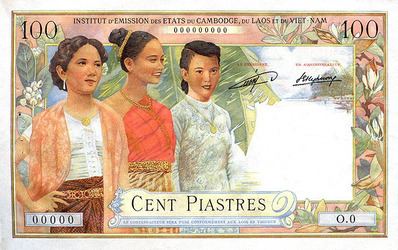1/100 cent | Symbol p | |
 | ||
Banknotes 10, 20, 50 cents, 1, 5, 10, 20, 50, 100, 200, 500 piastres Coins ¼, ½, 1, 5, 10, 20, 50 cents 1 piastre | ||
The piastre de commerce was the currency of French Indochina between 1885 and 1952. It was subdivided into 100 cent, each of 5 sapèque.
Contents
The name piastre (French pronunciation: [pjastʁ]), from Spanish pieces of eight (pesos), dates to the 16th century and has been used as the name of many different historical units of currency.
History
Prior to the arrival of the French in Indo-China in the second half of the 19th century, cash coins similar to those used in the provinces of China circulated in the area that is nowadays known as Vietnam. There was also a silver milled dragon coin and associated subsidiary coinage in circulation. The dragon coin is believed to have been in imitation of the Spanish and Mexican silver dollars which also circulated widely in the region at that time, however the dragon dollars were worth less because the fineness of the silver was less than that in the Spanish and Mexican dollars. In the region that is nowadays Cambodia and Laos, the Siamese coinage circulated and Cambodia had its own regional varieties of the Siamese Tical (Thai Baht).
The French began their Indo-Chinese empire in 1862 with Cochin-China which is the area around the Mekong delta and Saigon, and which is nowadays the extreme southern part of Vietnam. This empire very quickly expanded to include Cambodia which had been a vassal state of the Kingdom of Siam. In 1875, the French introduced a Cambodian franc to Cambodia. Although these francs were minted in Belgium between 1875 and 1885, they always bore the date 1860. The French also began to introduce a subsidiary coinage in 'cents' into Cochin-China in the late 1870s. These cents were actually subsidiary coinage of the Mexican dollar unit as opposed to being subsidiary coinage of the French franc.
In 1884, the French Indo-Chinese empire further expanded to incorporate Annam and Tonkin-China. The following year, in 1885, the French introduced a new silver piastre de commerce and associated subsidiary coinage throughout the entire Indo-Chinese colonies in order to increase monetary stability. The piastre was initially equivalent to the Mexican peso. The piastre was therefore a direct lineal descendent of the Spanish pieces of eight that had been brought to the Orient from Mexico on the Manila Galleons. It was initially on a silver standard of 1 piastre = 24.4935 grams pure silver. This was reduced to 24.3 grams in 1895.
French Indo-China was one of the last places to abandon the silver standard. The piastre remained on the silver standard until 1920, when due to the rise in the price of silver after the First World War, it was pegged to the French franc at a varying rate hence putting it unto a gold exchange standard. The silver standard was restored in 1921 and maintained until 1930, when the piastre was pegged to the franc at a rate of 1 piastre = 10 francs. During the World War II Japanese occupation, an exchange rate of 0.976 piastre = 1 Japanese yen operated, with the pre-war peg to the franc restored after the war. However, in December 1945, to avoid the French franc's devaluation, the peg was changed to 1 piastre = 17 francs.
In 1946, the North Vietnamese đồng was introduced, which replaced the piastre at par. In 1952/1953, the Lao kip (1952), Cambodian riel (1953), and South Vietnamese đồng (1953) were introduced at par with the piastre. Initially, the paper money bore denominations both in the local currency and the piastre, but coins were denominated in the national units since the beginning. These initially circulated alongside the old piastre currency. The peg of 1 piastre = 10 francs was restored in 1953. The dual denominated notes circulated until 1955 in South Vietnam and Cambodia, and 1957 in Laos.
Coins
The coin was first introduced in 1880 then 1883 then in 1885 as so on. In 1885, bronze 1 cent and silver 10, 20 and 50 cent and 1 piastre coins were introduced. These were followed in 1887 by holed, bronze 1 sapeque. In 1895, the weights of the silver coins were reduced, due to the reduction in the silver peg of the currency. From 1896, the 1 cent was also a holed coin. In 1923, holed, cupro-nickel 5 cent were introduced, followed by holed, bronze ½ cent in 1935.
In 1939, zinc ½ cent and both nickel and cupro-nickel 10 and 20 cent coins were introduced. Coins in the name of the État Français were issued between 1942 and 1944 in denominations of ¼, 1 and 5 cent. All three were holed, with the ¼ cent in zinc and the other two in aluminium. In 1945, aluminium 10 and 20 cent were introduced, followed by unholed aluminium 5 cent and cupro-nickel 1 piastre coins. The last piastre coins were issued in the name of the "Indochinese Federation".
The first Lao kip coins were dated 1952, while the first South Vietnamese đồng and Cambodian riel were dated 1953.
